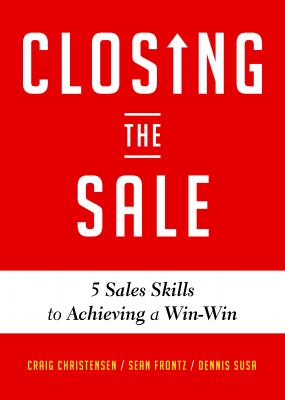ТОП просматриваемых книг сайта:
Closing the Sale. Craig Christensen
Читать онлайн.Название Closing the Sale
Год выпуска 0
isbn 9781642500943
Автор произведения Craig Christensen
Жанр Банковское дело
Издательство Ingram
Help the client enough to meet your goals.
Be a consultant and trusted advisor to the client.
Your role
CLOSING THE SALE
To understand the power of intent, imagine you are a buyer. Think about some significant purchases you have made.
As a buyer, have you ever:
Been pressured to make a decision too quickly?
Felt like you were “being sold”?
Become confused and overwhelmed by features/capabilities that weren’t important to you?
Was the interaction all about you or all about them?
In contrast, think of a time when you consulted someone you trusted on a matter of importance—someone who had your best interest at heart.
How did that person approach the process?
How did it make you feel?
How did it impact your willingness to share vital information?
You may have just thought of a friend, family member, or trusted advisor. What is it that makes it easy to have good intent with friends and family, but challenging with business associates?
The irony is, the harder you try to “sell” people, the less willing they are to be “sold.” Most people can feel when they’re being manipulated or led to your conclusion, and they will often move aggressively in the opposite direction. When people feel their choice is being restricted, they
become highly motivated to push back. It’s an emotional response. When trust is compromised, the information flow from clients is severely curtailed, and you are far less able or likely to craft solutions that meet their needs.
If your intent is to help clients succeed, clients will be more likely to share their beliefs about what success is. And the better you understand your client, the better decisions your client will make.
Conversely, when clients perceive that your intent is to help them succeed, they are more likely to share their own beliefs about what success is. And the better you understand what a client wants and needs, the better the choices you can bring to the table. It is in your own best interest to focus on the interests of your client first.
Consider Your Own Experiences
Think about a solution you’ve sold using brute force. What happened? Was it wildly successful? Was the client truly happy? Or did it come back to bite you?
Think about situations where you were pushed to buy something you really didn’t need or want? How did you feel? Who did you blame?
Your role
The irony is, the harder you try to sell people, the less willing they are to be sold.
Ever taken a solution off the table because you knew it wasn’t the right fit for the client? Did you gain or lose credibility by doing so? How did the customer react?
Three Types of Decisions
When clients make “closing” decisions—whether incremental or final—they usually come down to one of three choices:
Choice 1: Go. Proceed as suggested.
Choice 2: Go with changes. Proceed, but with changes to the proposed plan.
Choice 3: No-Go. Decide not to proceed.
To be successful in the Closing Zone, it’s helpful to be familiar with all three types of decisions.
In the chapters that follow, we’ll talk more about the importance of each of these categories, and the factors that influence the decisions you’ll ask clients to make in your meetings.
Your role
CLOSING THE SALE
But first, let’s pause to consider the answer salespeople dread hearing, especially in the closing stages of a sales cycle: “No.”
Most of us have been conditioned since childhood that “no” means, well, no. The word suggests a hard stop, a cease-and-desist notice, or an irreversible outcome. You heard it from your parents when you asked for candy in the checkout lane of the grocery store. You heard it as a teenager when you wanted to borrow the family car. Even as an adult, you hear it—maybe from your spouse when you do something like proposing to spend the bonus check on a hobby that suits only your interests.
In fact, hundreds of sales-training programs have developed specific language and techniques to prevent customers from saying no, and have tried slick ways to get around it or avoid it altogether. Battle cries like “Never take no for an answer,” and “Salesmanship begins when the customer says no,” have stuck in salespeople’s heads and influenced what they believe and how they behave.
No is a matter of perspective. Some see it as a stumbling block; others see it as a stepping-stone. What if you shifted your thinking and chose to see “no” not as a rejection, but as an opportunity?
No is a matter of perspective. Some see it as a stumbling block; others see it as a stepping-stone.
CLOSING THE SALE
What if you changed your instinctive response of perceiving “no” as a roadblock and thought of it as a detour sign that served to redirect you away from a potential hazard—and onto a route that could yield a better outcome for your client and you?
Saying no is always an option for the client. Not accepting this reality only creates resistance from your client, and worse, mistrust of your intent to help them succeed. Believe it or not, affirming the client’s choice to say no can be extraordinarily powerful, and can provide much-needed insight on what it will take to get to “yes.” There is power in hearing a “no”—if you know how to respond constructively.
When you receive a “no,” you get important information. It’s a signal that tells you to begin looking for other ways to accomplish outcomes the client wants in a way they feel good about. Most people, when they feel they have the “permission” and the freedom to choose, are often more willing to commit to making a decision.
Enabling a “no” decision means you truly understand the client’s position and

